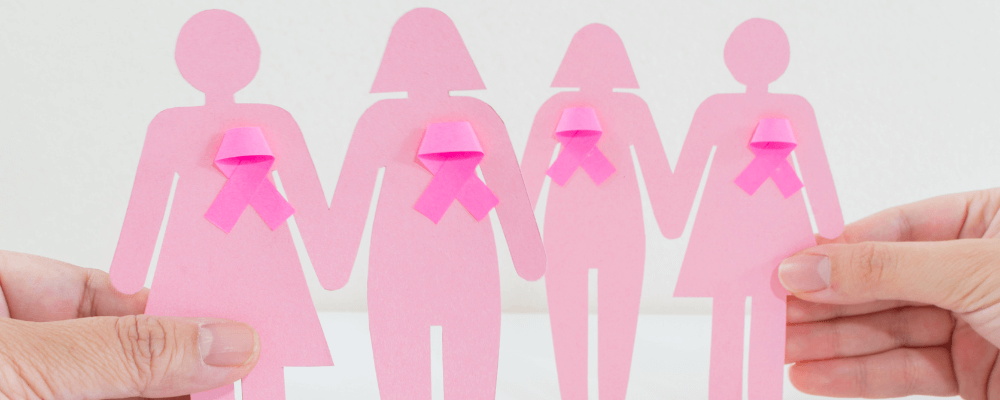Understanding the Different Types of Breast Cancer

According to the American Cancer Society (ACS), Breast cancer is one of the most common cancers affecting women worldwide, and females in the U.S. have a 13% chance of developing breast cancer. However, breast cancer can affect people of any gender or sex.
Breast Cancer occurs when cells in the breast start to grow uncontrollably and unnaturally, forming a tumor. This can be different from one person to another based on the breast cancer type, how it behaves, and where it starts.
In this blog, we will explore the different types of breast cancer. A person may find it helpful to learn about breast anatomy.
What Is Breast Cancer?
Breast cancer starts when cells in the breast tissue grow and divide faster than normal cells. This can lead to the formation of a mass or lump in the breast, commonly called a tumor. Not all breast lumps are cancerous, but it’s essential to understand the different types of breast cancer to get the correct diagnosis and treatment.
Breast cancer happens when cells in the breast grow too quickly and form a lump or tumor. Not all lumps are cancerous, but knowing the different types is essential for getting the right treatment.
1. Ductal Carcinoma In Situ (DCIS)
Ductal Carcinoma In Situ (DCIS) is one of the earliest forms of breast cancer. It is a non-invasive type of breast cancer that hasn’t spread outside the milk ducts into the surrounding breast tissue.
It's usually found through a mammogram and doesn't cause many symptoms.
Key Features of DCIS:
- Non-invasive
- High success rate with early treatment
- Usually detected through mammography
2. Invasive Ductal Carcinoma (IDC)
Invasive Ductal Carcinoma (IDC) is the most common type of breast cancer, making up about 80% of all breast cancer cases. IDC starts in the milk ducts and spreads to other breast tissues.
This type of cancer can spread to other parts of the body if not detected early.
Key Features of IDC:
- The most common type of breast cancer
- Starts in the milk ducts and spreads to other breast tissues
- Can spread to other parts of the body (metastasis)
3. Lobular Carcinoma In Situ (LCIS)
Lobular Carcinoma In Situ (LCIS) is not considered true breast cancer but rather a condition where abnormal cells are found in the milk-producing lobules of the breast. This isn't real cancer but a condition where abnormal cells are in the milk-producing parts of the breast.
It increases the risk of getting real breast cancer later.
Key Features of LCIS:
- Non-invasive
- Increases the risk of developing unwanted breast cancer
- Often found incidentally during a breast biopsy
4. Invasive Lobular Carcinoma (ILC)
Invasive Lobular Carcinoma (ILC) is the second most common type of invasive breast cancer, after IDC. ILC starts in the lobules of the breast and spreads to nearby tissues. This is the second most common invasive breast cancer, beginning in the milk-producing parts and spreading.
It can be hard to detect because it doesn't always form a lump.
Key Features of ILC:
- The second most common invasive breast cancer
- Harder to detect due to its growth pattern
- It can spread to other parts of the body
5. Triple-Negative Breast Cancer
Triple-negative breast Cancer is a rare but aggressive type of breast cancer. It lacks three common receptors (estrogen, progesterone, and HER2) that are typically found in most breast cancers. Since it doesn’t respond to hormonal therapy or HER2-targeted treatments, triple-negative breast cancer is often more challenging to treat.
Key Features of Triple-Negative Breast Cancer:
- Aggressive and fast-growing
- Doesn’t respond to hormonal or HER2-targeted therapies
- Often treated with chemotherapy, radiation, or surgery
6. HER2-Positive Breast Cancer
HER2-positive breast Cancer is another aggressive form of breast cancer. In this type, cancer cells produce excess HER2 protein, which promotes their growth. This is a rare, aggressive type that lacks specific receptors, making it difficult to treat. It doesn't respond to hormone or HER2 treatments.
So it's often treated with chemotherapy, radiation, or surgery.
Key Features of HER2-Positive Breast Cancer:
- Aggressive but treatable with targeted therapies
- Overproduction of the HER2 protein
- Can be treated with drugs like trastuzumab (Herceptin)
7. Inflammatory Breast Cancer (IBC)
Inflammatory Breast Cancer (IBC) is a rare and aggressive form of breast cancer that affects the skin and lymph vessels of the breast. This type of cancer causes the breast to become red, swollen, and warm, often with a rash or dimpled skin texture. Because of its aggressive nature,
IBC is often diagnosed at a more advanced stage.
Key Features of IBC:
- Rare but aggressive
- Causes redness and swelling of the breast
- Diagnosed at advanced stages due to rapid progression
8. Paget’s Disease of the Breast
Paget’s Disease of the Breast is a rare form of breast cancer that starts in the skin of the nipple and extends to the areola. This type of cancer often accompanies either DCIS or invasive breast cancer. Symptoms include redness, itching, and flaking skin around the nipple.
Key Features of Paget’s Disease:
- Affects the nipple and areola
- Accompanied by DCIS or invasive breast cancer
- Often mistaken for a skin condition
9. Metastatic Breast Cancer
Metastatic Breast Cancer, also known as Stage IV breast cancer, is when cancer has spread to other parts of the body, such as the brain, lungs, liver, and bones. This stage of breast cancer is considered incurable, but treatments are available to control the spread and manage symptoms.
Key Features of Metastatic Breast Cancer:
- Cancer has spread to other parts of the body
- Incurable, but treatable
- Focus on controlling the spread and managing symptoms
10. Phyllodes Tumor
Phyllodes Tumor is a rare type of breast tumor that develops in the breast's connective tissue (stroma) rather than its ducts or lobules. These tumors can be benign, borderline, or malignant. Surgery is usually the primary treatment for phyllodes tumors.
Key Features of Phyllodes Tumor:
- Rare and develops in the connective tissue of the breast
- Can be benign, borderline, or malignant
- Treated with surgery
How Is Breast Cancer Diagnosed?
Breast cancer diagnosis typically involves several steps, including:
- Breast Self-Exams: Checking for lumps or changes in the breast.
- Mammography: A low-dose X-ray of the breast to detect abnormalities.
- Ultrasound: Used to evaluate abnormal findings in a mammogram further.
- Biopsy: Removing a small tissue sample for laboratory testing.
- MRI: Imaging is used in some instances to detect cancer that may not appear on a mammogram.
According to the American Cancer Society, the 5-year survival rates for individuals with invasive breast cancer vary depending on how far the cancer has spread:
- Localized (only in the breast): 99% survival rate
- Regional (spread to lymph nodes): 86% survival rate
- Distant (spread to other parts of the body): 28% survival rate
Conclusion
Understanding the different types of breast cancer is essential for proper diagnosis and treatment. Early detection is key, and with advancements in breast cancer treatment, the prognosis for many types of breast cancer has improved significantly. If you or a loved one has been diagnosed with breast cancer, it's essential to work closely with a healthcare provider to explore all treatment options available.
By understanding these breast cancer types, patients can take informed steps toward effective treatment and better outcomes.
Sources:
- American Cancer Society: Breast Cancer Overview
- National Cancer Institute: Breast Cancer Types
- Mayo Clinic: Breast Cancer Diagnosis and Treatment


